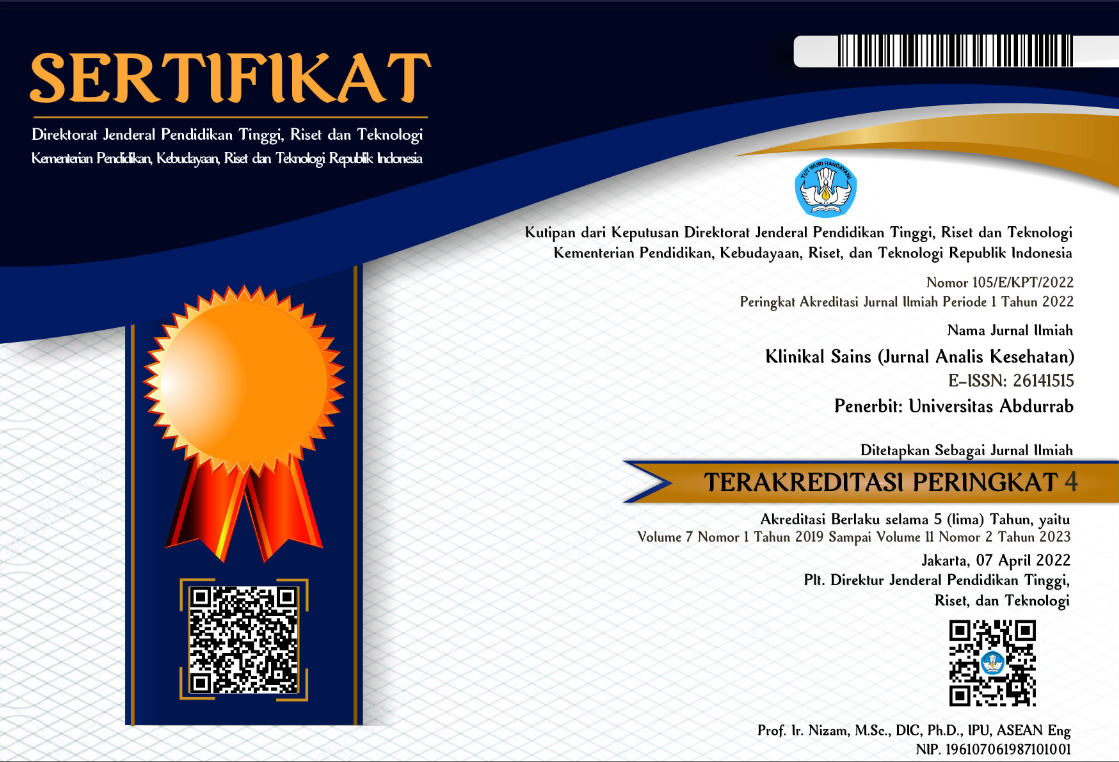EFEKTIVITAS PEMBUATAN SEDIAAN TETES TEBAL MALARIA MENGGUNAKAN DARAH K3EDTA DENGAN MODIFIKASI PENAMBAHAN CaCl2
Abstract
Malaria remains a problem in South Kalimantan, with a malaria elimination rate of 53.8%. Accurate diagnosis is crucial for malaria elimination. The malaria diagnostic method utilized is the microscopic examination, which is easy and affordable. This method involves preparing thick and thin blood smears using capillary blood. However, when an anticoagulant is used in the preparation of thick blood smears for malaria, such as blood with anticoagulant, it may cause the blood smear to peel off or not adhere to the glass slide during hemolysis. Calcium chloride (CaCl2) is one of the reagents used in the hematology laboratory for prothrombin time testing. CaCl2 can activate platelets in blood with the anticoagulant K3EDTA to induce clotting. This study aimed to determine the concentration of CaCl2 that produces a 1.5 cm diameter thick blood smear for malaria. The experimental method was employed for this purpose. CaCl2 solutions were prepared at concentrations of 10%, 9%, 8%, 7%, 6%, 5%, 4%, 3%, 2%, 1%, and 0.1%. Microscopic examination results showed clear lysis of red blood cells, distinct leukocytes, and visible Plasmodium vivax parasites. The ANOVA test yielded a significance value of 0.00, indicating a difference in the diameter of thick blood smears for malaria prepared using blood with anticoagulant reacted with CaCl2. Based on the Post Hoc test, the concentration of CaCl2 that yielded favorable results for preparing thick blood smears for malaria was 4%, resulting in a diameter of 1.5 cm
Copyright (c) 2023 Klinikal Sains : Jurnal Analis Kesehatan

This work is licensed under a Creative Commons Attribution-NonCommercial-ShareAlike 4.0 International License.
1. Copyright of all journal manuscripts is held by the Klinikal Sains : Jurnal Analis Kesehatan
2. Formal legal provisions to access digital articles of electronic journal are subject to the provision of the Creative Commons Attribution-ShareAlike license (CC BY-NC-SA), which means that Klinikal Sains : Jurnal Analis Kesehatan is rightful to keep, transfer media/format, manage in the form of databases, maintain, and publish articles.
3. Published manuscripts both printed and electronic are open access for educational, research, and library purposes. Additionally, the editorial board is not responsible for any violations of copyright law.
licensed under a Creative Commons Attribution-ShareAlike 4.0 International License.
 pdf
pdf
 Abstract views: 113
Abstract views: 113
 downloads: 114
downloads: 114

 :
:






